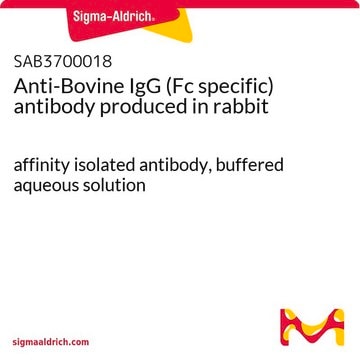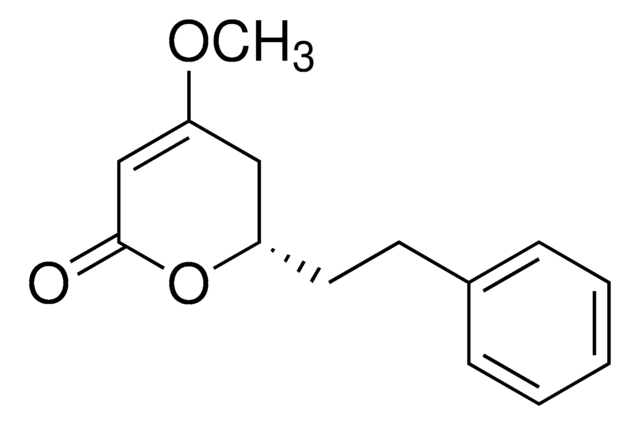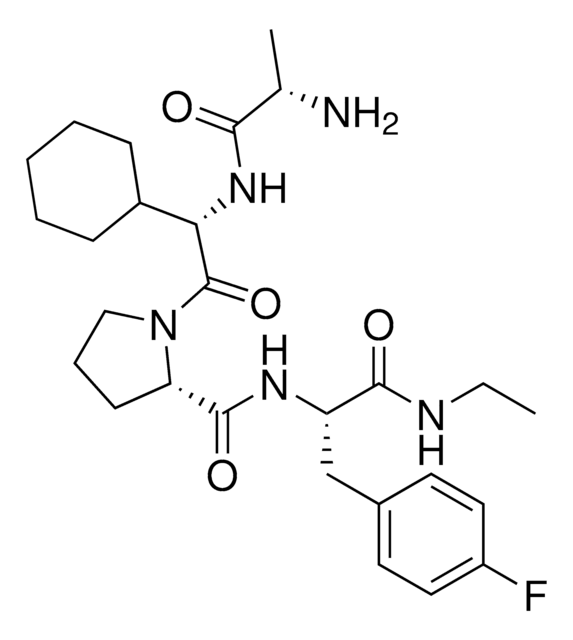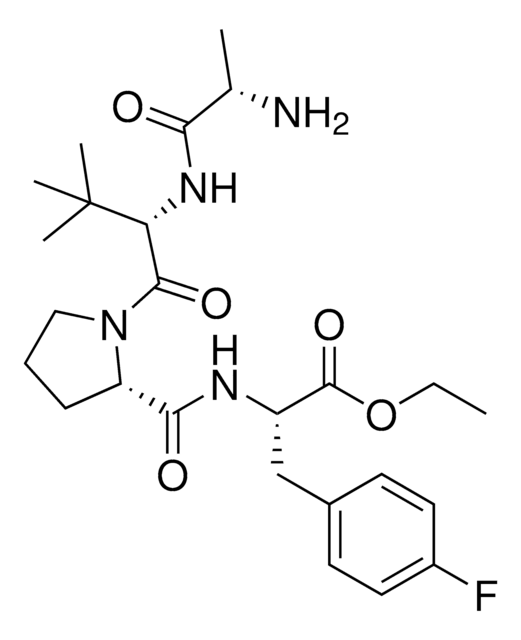价格与库存信息目前不能提供
推荐产品
生物源
rabbit
品質等級
抗體表格
serum
抗體產品種類
primary antibodies
無性繁殖
polyclonal
形狀
liquid
包含
≤0.1% Sodium azide as preservative
物種活性
Drosophila, hamster, rat, human, monkey, mouse
製造商/商標名
Calbiochem®
儲存條件
OK to freeze
avoid repeated freeze/thaw cycles
同型
IgG
運輸包裝
wet ice
儲存溫度
−20°C
目標翻譯後修改
unmodified
一般說明
Rabbit polyclonal antibody supplied as undiluted serum. Recognizes the ~35 kDa CHIP protein.
Recognizes the ~35 kDa CHIP protein. May also detect bands at ~43, ~51, and ~70 kDa corresponding to the mono-ubiquitinated, di-ubiquitinated, and dimeric forms of CHIP, respectively.
This Anti-CHIP Rabbit pAb is validated for use in Immunoblotting for the detection of CHIP.
免疫原
a recombinant protein consisting of full-length human CHIP fused to a His•Tag sequence
應用
Immunoblotting (1:200-1:1000)
Immunofluorescence (1:250)
Immunoprecipitation (1:20)
Immunofluorescence (1:250)
Immunoprecipitation (1:20)
警告
Toxicity: Standard Handling (A)
外觀
Undiluted serum.
重構
Following initial thaw, aliquot and freeze (-20°C).
分析報告
Positive Control
COS-7 cells
COS-7 cells
其他說明
May also detect bands at 43, 51, and 70 kDa, wich correspond to the mono-ubiquitinated, di-ubiquitinated, and dimeric forms of CHIP, respectively. Antibody should be titrated for optimal results in individual systems.
Xu, W., et al. 2002. Proc. Natl. Acad. Sci. USA99, 12847.
Demand, J., et al. 2001. Curr. Biol.11, 1569.
Connell, P., et al. 2001. Nat. Cell Biol.3, 93.
Jiang. J., et al. 2001. J. Biol. Chem. 276, 42938.
Meacham, G.C., et al. 2001. Nat. Cell. Biol.3, 100.
Ballinger, C.A., et al. 1999. Mol. Cell. Biol.19, 4535.
Demand, J., et al. 2001. Curr. Biol.11, 1569.
Connell, P., et al. 2001. Nat. Cell Biol.3, 93.
Jiang. J., et al. 2001. J. Biol. Chem. 276, 42938.
Meacham, G.C., et al. 2001. Nat. Cell. Biol.3, 100.
Ballinger, C.A., et al. 1999. Mol. Cell. Biol.19, 4535.
法律資訊
CALBIOCHEM is a registered trademark of Merck KGaA, Darmstadt, Germany
未找到合适的产品?
试试我们的产品选型工具.
儲存類別代碼
10 - Combustible liquids
水污染物質分類(WGK)
WGK 1
閃點(°F)
Not applicable
閃點(°C)
Not applicable
Britney N Lizama et al.
The Journal of neuroscience : the official journal of the Society for Neuroscience, 38(31), 6825-6840 (2018-06-24)
The C terminus of HSC70-interacting protein (CHIP, STUB1) is a ubiquitously expressed cytosolic E3-ubiquitin ligase. CHIP-deficient mice exhibit cardiovascular stress and motor dysfunction before premature death. This phenotype is more consistent with animal models in which master regulators of autophagy
Jeannette N Stankowski et al.
Antioxidants & redox signaling, 14(10), 1787-1801 (2010-08-04)
The decision to remove or refold oxidized, denatured, or misfolded proteins by heat shock protein 70 and its binding partners is critical to determine cell fate under pathophysiological conditions. Overexpression of the ubiquitin ligase C-terminus of HSC70 interacting protein (CHIP)
Nadja Kettern et al.
PloS one, 6(1), e16398-e16398 (2011-02-02)
The maturation of mouse macrophages and dendritic cells involves the transient deposition of ubiquitylated proteins in the form of dendritic cell aggresome-like induced structures (DALIS). Transient DALIS formation was used here as a paradigm to study how mammalian cells influence
Rudolf A Kley et al.
Brain : a journal of neurology, 135(Pt 9), 2642-2660 (2012-09-11)
Mutations in FLNC cause two distinct types of myopathy. Disease associated with mutations in filamin C rod domain leading to expression of a toxic protein presents with progressive proximal muscle weakness and shows focal destructive lesions of polymorphous aggregates containing
Xinjia Wang et al.
Molecular endocrinology (Baltimore, Md.), 19(6), 1474-1482 (2005-03-12)
The ubiquitin/proteasome-dependent protein degradation pathway (UPP) is responsible for the accelerated down-regulation of glucocorticoid receptor (GR) levels in cells subjected to chronic glucocorticoid exposure. Whereas hormone-dependent down-regulation of GR operates in most cells, the receptor is not down-regulated after long-term
Active Filters
我们的科学家团队拥有各种研究领域经验,包括生命科学、材料科学、化学合成、色谱、分析及许多其他领域.
联系技术服务部门








